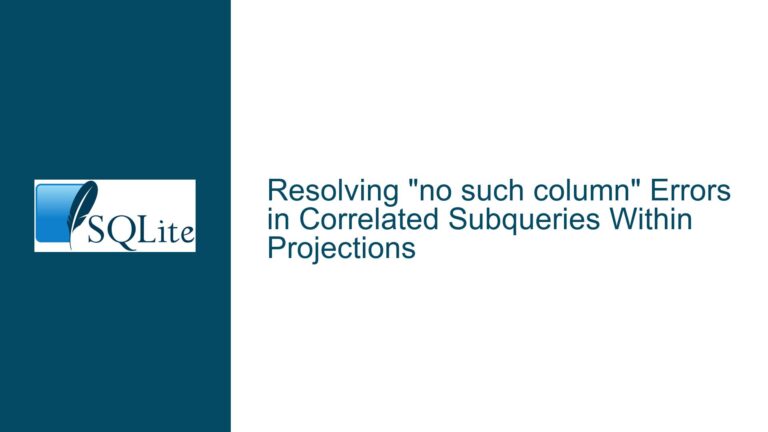Recursive CTE Infinite Loop in Graph Traversal Due to Missing Alias
Issue Overview: Recursive CTE Fails to Prevent Infinite Loops in Cyclic Graphs
When working with recursive Common Table Expressions (CTEs) in SQLite, one common use case is traversing graph structures stored in a table. In this scenario, the goal is to find all possible paths from a starting node while avoiding infinite loops caused by cycles in the graph. The provided recursive CTE attempts to achieve this by constructing JSON arrays representing paths and ensuring that no node is visited more than once in a single path. However, the initial implementation fails to prevent infinite recursion when the graph contains cycles, such as the edge F -> A in the provided edges table.
The core issue lies in the recursive CTE’s inability to correctly enforce the constraint that prevents revisiting nodes. The condition target NOT IN (SELECT value FROM json_each(path)) is intended to exclude nodes already present in the current path. However, due to a subtle oversight in the query’s structure, this condition does not function as expected, leading to infinite recursion when traversing cyclic graphs.
The problem is resolved by introducing an alias for the recursive CTE (paths p) and ensuring that the JSON path extraction and insertion operations reference the correct alias. This adjustment allows the recursive CTE to correctly track visited nodes and avoid infinite loops.
Possible Causes: Why the Recursive CTE Fails to Handle Cycles
The failure of the recursive CTE to handle cycles in the graph can be attributed to several factors, all of which stem from the initial query’s structure and SQLite’s handling of recursive CTEs.
First, the absence of an alias for the recursive CTE (paths) in the initial query causes ambiguity in the references to the path column. When the recursive CTE is joined with the edges table, SQLite cannot correctly resolve the references to path in the json_extract and json_each functions. This ambiguity leads to incorrect evaluation of the target NOT IN (SELECT value FROM json_each(path)) condition, effectively rendering it ineffective in preventing revisits to nodes.
Second, the recursive CTE’s structure does not explicitly enforce a termination condition based on the depth of recursion or the length of the path. While the target NOT IN condition is intended to serve as a termination mechanism, its failure due to the alias issue means that the recursion continues indefinitely when cycles are present.
Third, the use of JSON functions (json_array, json_insert, json_extract, and json_each) introduces additional complexity. These functions are powerful for manipulating JSON data but require precise handling to ensure that the correct data is referenced at each step of the recursion. The initial query’s failure to alias the recursive CTE exacerbates this complexity, leading to incorrect behavior.
Finally, the recursive CTE’s reliance on the UNION ALL operator means that it continues to generate new rows as long as the recursive part of the query produces results. Without a proper mechanism to prevent revisits to nodes, this results in an infinite loop when cycles are present in the graph.
Troubleshooting Steps, Solutions & Fixes: Resolving Infinite Loops in Recursive CTEs
To resolve the infinite loop issue in the recursive CTE, the following steps and solutions can be applied. These steps address the root causes identified earlier and ensure that the CTE correctly handles cyclic graphs.
Step 1: Alias the Recursive CTE to Resolve Reference Ambiguity
The primary issue in the initial query is the lack of an alias for the recursive CTE (paths). By introducing an alias (p), the query can correctly reference the path column in the recursive part of the CTE. This ensures that the json_extract and json_each functions operate on the correct data.
The corrected query is as follows:
WITH RECURSIVE paths(path) AS (
SELECT json_array(source, target) FROM edges
WHERE source = 'A' AND target <> source
UNION ALL
SELECT json_insert(p.path, '$[#]', e.target) FROM paths p
JOIN edges e
ON e.source = json_extract(p.path, '$[#-1]')
AND e.target NOT IN (SELECT value FROM json_each(p.path))
) SELECT * FROM paths;
In this version, the alias p is used to reference the path column in the recursive part of the CTE. This eliminates the ambiguity in the references to path and ensures that the target NOT IN condition is evaluated correctly.
Step 2: Verify the Correctness of JSON Function Usage
The use of JSON functions (json_array, json_insert, json_extract, and json_each) is critical to the recursive CTE’s operation. To ensure that these functions work as intended, it is important to verify their usage in the context of the recursive query.
json_array(source, target): This function constructs a JSON array containing thesourceandtargetnodes of each edge. It is used in the non-recursive part of the CTE to initialize the paths.json_insert(p.path, '$[#]', e.target): This function appends thetargetnode of the current edge to the JSON array representing the path. It is used in the recursive part of the CTE to extend the paths.json_extract(p.path, '$[#-1]'): This function extracts the last node in the JSON array representing the path. It is used to determine the current node in the path and join it with theedgestable.json_each(p.path): This function converts the JSON array representing the path into a set of rows, each containing a value from the array. It is used in thetarget NOT INcondition to check if thetargetnode is already in the path.
By ensuring that these functions are used correctly and that their inputs are properly referenced using the alias p, the recursive CTE can accurately track and extend paths without revisiting nodes.
Step 3: Test the Recursive CTE with Cyclic and Acyclic Graphs
After making the necessary adjustments to the recursive CTE, it is important to test its behavior with both cyclic and acyclic graphs. This ensures that the CTE correctly handles all cases and does not enter infinite loops.
For the provided edges table, which includes the cyclic edge F -> A, the corrected CTE should produce the following output:
path
["A", "B"]
["A", "E"]
["B", "C"]
["E", "C"]
["C", "D"]
["C", "F"]
["D"]
["F", "A"]
["F", "A", "B"]
["F", "A", "E"]
["F", "A", "B", "C"]
["F", "A", "E", "C"]
["F", "A", "B", "C", "D"]
["F", "A", "E", "C", "D"]
["F", "A", "B", "C", "F"]
["F", "A", "E", "C", "F"]
This output demonstrates that the CTE correctly constructs paths without entering infinite loops, even in the presence of cycles. Each path is extended only if the target node is not already in the path, as enforced by the target NOT IN condition.
Step 4: Optimize the Recursive CTE for Performance
While the corrected CTE handles cycles correctly, it is important to consider its performance, especially for large graphs. The following optimizations can be applied to improve the efficiency of the recursive CTE:
Indexing the
edgesTable: Creating indexes on thesourceandtargetcolumns of theedgestable can significantly speed up the joins in the recursive part of the CTE.CREATE INDEX idx_source ON edges(source); CREATE INDEX idx_target ON edges(target);Limiting Path Length: If the application does not require paths beyond a certain length, a termination condition based on path length can be added to the recursive CTE. This prevents the CTE from generating excessively long paths and reduces the computational overhead.
WITH RECURSIVE paths(path, length) AS ( SELECT json_array(source, target), 1 FROM edges WHERE source = 'A' AND target <> source UNION ALL SELECT json_insert(p.path, '$[#]', e.target), p.length + 1 FROM paths p JOIN edges e ON e.source = json_extract(p.path, '$[#-1]') AND e.target NOT IN (SELECT value FROM json_each(p.path)) AND p.length < 10 -- Limit path length to 10 ) SELECT * FROM paths;Using Temporary Tables for Intermediate Results: For very large graphs, storing intermediate results in temporary tables can reduce memory usage and improve performance. This approach involves breaking the recursive CTE into multiple steps and storing the results of each step in a temporary table.
By applying these optimizations, the recursive CTE can handle larger graphs more efficiently while maintaining correctness in the presence of cycles.
Step 5: Consider Alternative Approaches for Graph Traversal
While recursive CTEs are a powerful tool for graph traversal in SQLite, they are not the only option. Depending on the specific requirements of the application, alternative approaches may be more suitable. Some alternatives include:
Iterative Application-Level Traversal: Implementing graph traversal logic in the application code (e.g., using a programming language like Python or Java) can provide more flexibility and control over the traversal process. This approach allows for custom logic to handle cycles, path length limits, and other constraints.
Using a Graph Database: For applications that require complex graph operations, a dedicated graph database (e.g., Neo4j) may be more appropriate. Graph databases are optimized for traversing and querying graph structures and provide built-in support for handling cycles and other graph-specific challenges.
Preprocessing the Graph: If the graph is static or changes infrequently, preprocessing the graph to identify and handle cycles can simplify the traversal logic. This approach involves analyzing the graph structure and storing additional metadata (e.g., cycle flags) that can be used during traversal.
By considering these alternatives, developers can choose the most appropriate approach for their specific use case and avoid the limitations of recursive CTEs in SQLite.
Conclusion
Recursive CTEs are a powerful feature in SQLite for traversing graph structures, but they require careful handling to avoid infinite loops in the presence of cycles. The key to resolving the infinite loop issue lies in correctly aliasing the recursive CTE and ensuring that JSON functions reference the correct data. By following the troubleshooting steps and solutions outlined in this guide, developers can effectively use recursive CTEs to traverse cyclic graphs while maintaining performance and correctness. Additionally, considering alternative approaches for graph traversal can provide further flexibility and optimization opportunities for complex use cases.






